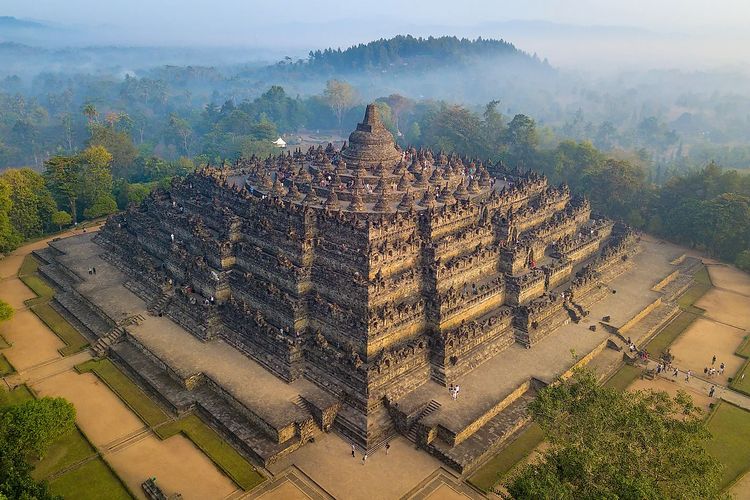The Indonesian government has come under public scrutiny following the installation of a temporary stairlift at the UNESCO World Heritage Site, Borobudur Temple.
The lift was prepared to accommodate the upcoming state visit of French President Emmanuel Macron, who will be accompanied by President Prabowo Subianto during his tour of the iconic Buddhist monument.
Hasan Nasbi, Head of the Presidential Communication Office (PCO), assured the public that the stairlift does not damage the ancient temple’s structure.
“No drilling or nailing is involved. The installation is simply placed and can be easily dismantled,” he explained in Jakarta on Monday, May 26, 2025, as quoted by kontan.co.id.
The temporary structure aims to expedite the visit, considering President Macron’s limited schedule. “Unlike tourists, he won’t have a full day to explore. This facility will help him ascend each level efficiently,” Hasan added.
Religious Leaders Voice Concerns Over Cultural Integrity
Public reactions, however, have been mixed. Buddhist religious leader Upashaka Pandhita Tarra Lozhang expressed concern over the terminology used. The initial report of an “escalator” sparked confusion and worry among the public, with many imagining a shopping mall-style moving staircase.
“If it’s an escalator where people stand like in a mall, we object. But if the state insists, we cannot refuse—only express regret,” Tarra told tempo.co.
While Tarra acknowledged the clarification that the structure is a stairlift and not a conventional escalator, he emphasized the importance of protecting the temple’s structural integrity.
“Even with stairlifts, if any part is attached to the temple body, it could affect the interlocking stones,” he warned.
Tarra also criticized the lack of consultation with Buddhist communities before proceeding with the plan. “We were not invited to any dialogue about this.”
To balance state interests with preservation, Tarra proposed two alternative solutions: using a ceremonial stretcher as done for elderly monks during rituals, or covering the stairs with wooden planks to allow a wheelchair to be pushed up.
He referenced similar accommodations at Angkor Wat in Cambodia and Shwedagon Pagoda in Myanmar, though he admitted Borobudur’s steepness poses additional challenges.
Experts Urge Caution as Preservation Debate Intensifies
In defense of the installation, Dr. Ashar Saputra, a civil engineering lecturer at Gadjah Mada University, noted that stairlifts are not uncommon internationally and are designed to be lightweight and non-invasive.
“This is a single-user platform lift using a chair. The weight is around 250 kilograms max. The platform is cushioned with foam and wooden layers. It doesn’t require bolts or adhesives” he explained.
Based on engineering logic, he added, the load would not threaten the temple’s stability. Despite these assurances, some archaeologists remain uneasy. Goenawan Agoeng Sambodo, an independent researcher and epigraphy expert from UGM, voiced his concern on Facebook after photos and videos of the stairlift materials surfaced online.
“These posts are a reminder to uphold preservation principles. Modernization should not compromise irreplaceable historical and archaeological value,” he stated, as quoted by joglosemarnews.com.
Goenawan compared the silence over this project with the public outcry that occurred in 2024 when plans to install a ceremonial umbrella (catra) on top of the temple were proposed.
“Back then, archaeologists spoke out. Now, even with video evidence of a lift installation, there’s little response,” he said.
He also warned that bypassing heritage protocols could lead to Borobudur losing its UNESCO status, “Violating regulations carries serious consequences, including the loss of international recognition.”
As the debate unfolds, it remains clear that balancing accessibility and cultural preservation is no easy task. While the government views the stairlift as a practical solution for an important diplomatic visit, religious leaders and cultural experts urge caution and greater transparency in managing one of Indonesia’s most treasured historical sites.
Source: kontan.co.id, tempo.co, joglosemarnews.com
Special Photo Credit: via fatek.umsu.ac.id


